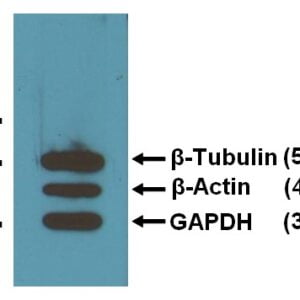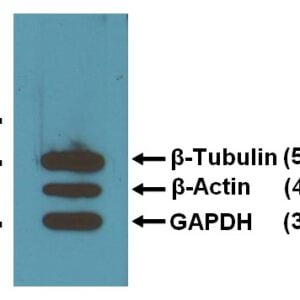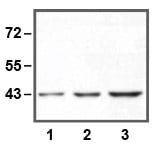| Weight | 1 lbs |
|---|---|
| Dimensions | 9 × 5 × 2 in |
| host | rabbit |
| isotype | IgG |
| clonality | polyclonal |
| concentration | 1 mg/mL |
| applications | ICC/IF, IHC, WB |
| available sizes | 100 µg |
rabbit anti-Hsp60 polyclonal antibody 9023
$409.00
Antibody summary
- Rabbit polyclonal to Hsp60
- Suitable for: WB, ICC/IF, IHC
- Reacts with: human, mouse, rat
- Isotype: IgG
- 100 µg
rabbit anti-Hsp60 polyclonal antibody 9023
| target relevance |
|---|
| Heat shock protein 60 (HSP60), also known as chaperonin 60, is a highly conserved molecular chaperone in mitochondria that assists in the folding and assembly of newly synthesized proteins, particularly under conditions of cellular stress. This antibody can be used as a loading control when run alongside proteins, particularly mitochondrail proteins, of interest with different and resolvable molecular weights and ideally in combination with antibodies of same host and when using a secondary antibody. Click for more on: loading controls and HSP60 |
| Protein names 60 kDa heat shock protein, mitochondrial (EC 5.6.1.7) (60 kDa chaperonin) (Chaperonin 60) (CPN60) (Heat shock protein 60) (HSP-60) (Hsp60) (Heat shock protein family D member 1) (HuCHA60) (Mitochondrial matrix protein P1) (P60 lymphocyte protein) |
| Gene names HSPD1,HSPD1 HSP60 |
| Protein family Chaperonin (HSP60) family |
| Mass 61055Da |
| Function FUNCTION: Chaperonin implicated in mitochondrial protein import and macromolecular assembly. Together with Hsp10, facilitates the correct folding of imported proteins. May also prevent misfolding and promote the refolding and proper assembly of unfolded polypeptides generated under stress conditions in the mitochondrial matrix (PubMed:11422376, PubMed:1346131). The functional units of these chaperonins consist of heptameric rings of the large subunit Hsp60, which function as a back-to-back double ring. In a cyclic reaction, Hsp60 ring complexes bind one unfolded substrate protein per ring, followed by the binding of ATP and association with 2 heptameric rings of the co-chaperonin Hsp10. This leads to sequestration of the substrate protein in the inner cavity of Hsp60 where, for a certain period of time, it can fold undisturbed by other cell components. Synchronous hydrolysis of ATP in all Hsp60 subunits results in the dissociation of the chaperonin rings and the release of ADP and the folded substrate protein (Probable). {ECO:0000269|PubMed:11422376, ECO:0000269|PubMed:1346131, ECO:0000305|PubMed:25918392}. |
| Catalytic activity CATALYTIC ACTIVITY: Reaction=ATP + H2O + a folded polypeptide = ADP + phosphate + an unfolded polypeptide.; EC=5.6.1.7; Evidence={ECO:0000305}; |
| Subellular location SUBCELLULAR LOCATION: Mitochondrion matrix. |
| Structure SUBUNIT: Homoheptamer arranged in a ring structure (PubMed:11422376, PubMed:1346131, PubMed:25918392). The functional units of these chaperonins consist of heptameric rings of the large subunit Hsp60, which function as a back-to-back double ring. Interacts with 2 heptameric Hsp10 rings to form the symmetrical football complex (PubMed:25918392). Interacts with HRAS (By similarity). Interacts with ATAD3A (PubMed:22664726). Interacts with ETFBKMT and EEF1AKMT3 (PubMed:23349634). Interacts with MFHAS1 (PubMed:24286120). {ECO:0000250|UniProtKB:P63038, ECO:0000269|PubMed:11422376, ECO:0000269|PubMed:1346131, ECO:0000269|PubMed:22664726, ECO:0000269|PubMed:23349634, ECO:0000269|PubMed:24286120, ECO:0000269|PubMed:25918392}.; SUBUNIT: (Microbial infection) Interacts with hepatitis B virus/HBV protein X. {ECO:0000269|PubMed:15120623}.; SUBUNIT: (Microbial infection) Interacts with HTLV-1 protein p40tax. {ECO:0000269|PubMed:1731090}. |
| Involvement in disease DISEASE: Spastic paraplegia 13, autosomal dominant (SPG13) [MIM:605280]: A form of spastic paraplegia, a neurodegenerative disorder characterized by a slow, gradual, progressive weakness and spasticity of the lower limbs. Rate of progression and the severity of symptoms are quite variable. Initial symptoms may include difficulty with balance, weakness and stiffness in the legs, muscle spasms, and dragging the toes when walking. In some forms of the disorder, bladder symptoms (such as incontinence) may appear, or the weakness and stiffness may spread to other parts of the body. {ECO:0000269|PubMed:11898127}. Note=The disease is caused by variants affecting the gene represented in this entry.; DISEASE: Leukodystrophy, hypomyelinating, 4 (HLD4) [MIM:612233]: A severe autosomal recessive hypomyelinating leukodystrophy. Clinically characterized by infantile-onset rotary nystagmus, progressive spastic paraplegia, neurologic regression, motor impairment, profound intellectual disability. Death usually occurs within the first two decades of life. {ECO:0000269|PubMed:18571143}. Note=The disease is caused by variants affecting the gene represented in this entry. |
| Target Relevance information above includes information from UniProt accession: P10809 |
| The UniProt Consortium |
Data
Publications
| pmid | title | authors | citation |
|---|---|---|---|
| We haven't added any publications to our database yet. | |||
Protocols
| relevant to this product |
|---|
| Western blot IHC ICC |
Documents
| # | SDS | Certificate | |
|---|---|---|---|
| Please enter your product and batch number here to retrieve product datasheet, SDS, and QC information. | |||
Only logged in customers who have purchased this product may leave a review.














Reviews
There are no reviews yet.